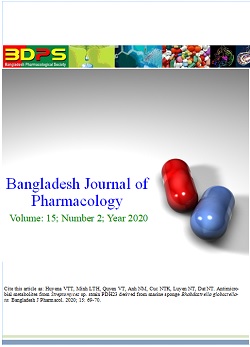Antimicrobial metabolites from Streptomyces sp. strain PDH23 derived from marine sponge Rhabdastrella globostellata
Abstract
Sponge-associated bacterial community has shown great potential as a source of biologically active constituents. The marine sponge Rhabdastrella globostellata has been known to display potent anticancer effects (Hirashima et al. 2010; Li et al., 2010, Aoki et al., 2007). Pandey et al. (2014) revealed that 18 of 127 microorganisms isolated from R. globostellata exhibited acetylcholinesterase inhibitory activity. However, the antimicrobial activity of R. globostellata associated bacteria has not been reported so far. In our search for antibacterial agents from marine organisms, the strain of Streptomyces sp. PDH23 isolated from R. globostellata, which was collected at depth of 10 m in Da Nang sea, Vietnam, was found to exhibit remarkable antimicrobial activity against Bacillus cereus (ATCC14579) and Candida albicans (ATCC1023) (see supplemental data).
References
Aoki S, Sanagawa M, Watanabe Y, Setiawan A, Arai M, Kobayashi M. Novel isomarabarican triterpenes, exhibiting selective antiproliferative activity against vascular endothelial cells, from marine sponge Rhabdastrella globostellata. Bioorg Med Chem. 2007; 15: 4818-28.
Breitmaier E. Structure elucidation by NMR. In: Organic chemistry: A practical guide. 3rd ed. John Wiley & Sons, Chichester, 2002.
Hirashima M, Tsuda K, Hamada T, Okamura H, Furukawa T, Akiyama S, Tajitsu Y, Ikeda R, Komatsu M, Doe M, Morimoto Y, Shiro M, van Soest RW, Takemura K, Iwagawa T. Cytotoxic isomalabaricane derivatives and a monocyclic triterpene glycoside from the sponge Rhabdastrella globostellata. J Nat Prod. 2010; 73: 1512-18.
Li J, Xu B, Cui J, Deng Z, de Voogd NJ, Proksch P, Lin W. Globostelletins A-I, cytotoxic isomalabaricane derivatives from the marine sponge Rhabdastrella globostellata. Bioorg Med Chem. 2010; 18: 4639-47.
Pandey S, Sree A, Sethi DP, Kumar CG, Kakollu S, Chowdhury L, Dash SS. A marine sponge associated strain of Bacillus subtilis and other marine bacteria can produce anticholinesterase compounds. Microb Cell Fact. 2014; 13: 24.
Teh CH, Nazni WA, Lee HL, Fairuz A, Tan SB, Mohd SA. In vitro antibacterial activity and physicochemical properties of a crude methanol extract of the larvae of the blowfly Lucilia cuprina. Med Vet Entomol. 2013; 27: 414-20.
Thai TH, Hai NT, Hien NT, Ha CTT, Cuong NT, Binh PT, Dang NH, Dat NT. Cytotoxic constituents of Mallotus microcarpus. Nat Prod Commun. 2017; 12: 407-08.

